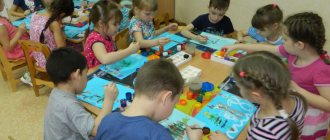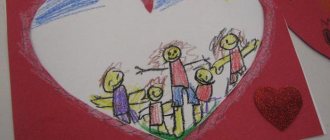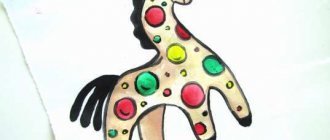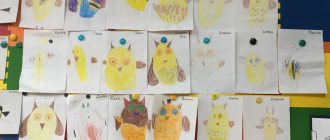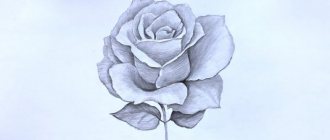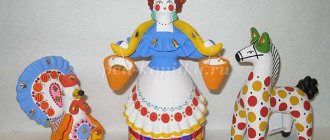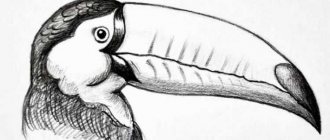so UNT / Fine arts / Lesson plans for fine arts 3rd grade
Lesson 21 DECORATIVE DRAWING “FUNNY TOYS” (gouache)
15.11.2013 8884 0
Goals:
to activate the stock of aesthetic knowledge and ideas of students on the topic, to ensure connections between new knowledge and previous knowledge, to show what is common and different in figurative solutions; develop observation and attention, logical thinking; to cultivate respect for the work of Russian craftsmen and hard work.
Equipment
:
Fine art: samples (photos) of Bogorodsk wooden carved toys, a sample of the educational toy “Funny Toys” (gouache).
During the classes
I. Class organization.
1. Greeting students.
2. Checking readiness for the lesson.
3. Preparing paints for work.
II. Setting the topic of the lesson.
Teacher. The topic of the lesson today will continue from the last lesson - “Funny Toys”. You will make a fun toy to give as a gift to friends.
III. Updating students' knowledge.
In the village of Bogorodskoye, Moscow Region, for a long time everyone, even women and children, carved toys from wood. The local craftsmen know the joy of creativity and understand the beauty of wood. They cut toys - bears and men, deer and eagles, horses and goats, cockerels and hens. The wood obeys every touch of the knife and cutter, which leave rhythmic marks, emphasizing the shape. The beauty of an unpainted toy largely depends on the expressiveness of the silhouette.
Here are real Bogorodsk toys. (The teacher shows the photographs.)
Remember how clever these toys are.
IV. Introductory conversation.
Teacher's word. You found interesting material about the Bogorodsk toy.
Tell us about the work of masters of carved wooden toys from the village of Bogorodskoye, Moscow region.
“The most common character in the Bogorodsk toy is a bear. In the hands of carvers, he is capable of any human task. He plays chess and football, flies on a rocket, works at the machine, sits by the phone or record player, reads, goes to school... Bogorodsk toys are made with love, good humor, great skill and artistic taste. They attract with a variety of qualities: a folklore plot, constructive ingenuity and an amazing sense of material, a sense of the nature of pure, light linden wood, untouched by paint.”
“In the hands of the carver, in the flickering of sharp chisels, a block of wood roughly hacked with an ax suddenly becomes a recognizable, familiar image. The large relief carving accurately builds the volume and then accurately completes it with fine patterned painting. The living surface of the Bogorodsk sculpture plays with many nuances of light and shadow, different rhythms of cutting. This miraculous transformation of a piece of wood into a plastic form, the birth before our eyes of a thing marked by the experience of many generations, can be observed in the village today. More than a hundred carvers work at the Bogorodsk artistic carving factory (opened in 1960). Their products are widely known and in great demand.”
V. Analysis of works of fine art.
The themes of Bogorodsk toys and sculpture are unusually wide and varied. These are images of village residents, horsemen (“riders”), teams of horses, or dogs, or deer, figures of domestic animals, birds, and animals. All of them, as a rule, are depicted as busy with some kind of activity. Particularly interesting for their unpredictability are the plots with the most popular hero of Bogorodsk sculpture - the bear. He performs some work alone or together with a person. The “Blacksmiths” toy, depicting a man and a bear alternately striking an anvil, has become a symbol of the craft. Often the bear plays football, flies into space, etc. Such plots are associated with the original transmission of movement in the acting characters. Simple designs with movable bars or a hidden spring provide the toy with the effect of movement. You can also change the place of shapes in space. Mobility brings a moment of surprise to a wooden toy, making it even more entertaining. For example, a toy with pecking chickens is surprisingly faithful and at the same time extremely comically reminiscent of the habits of real chickens. There are schematic but expressive figures of chickens and a rooster on a round board. A ball is suspended on strings under the board, and when rotated, the chickens begin to peck fussily.
The twitch bear's paws are movably fastened at the back; when the string is pulled, he begins to dance funny. There are toys with secret buttons, for example, Mishka will chop wood if you press such a button.
Parts or details of some toys are attached with springs for greater mobility, for example leaves on a tree. They begin to tremble if you touch such a toy.
When creating multi-figure compositions, masters use the design of so-called divorces, which allow them to change the grouping of characters and preserve the element of play.
VI. Working on new material.
For your own creativity, you used simple building materials - empty matchboxes, boxes. You can make technical toys, animals, doll furniture, and even dolls from boxes. You mainly made animal toys - bears, hares.
VII. Pedagogical drawing.
The teacher explains the sequence of painting a toy and shows examples.
– Watch how I paint my toy – a dog made from matchboxes and a cologne box (see Appendix)
.
1. First, I will paint the entire toy with a basic dark brown color. I try to paint in such a way that no brush marks are visible. I apply the paint to a uniform condition.
2. I outline dark spots on the dog, for this I mix black with dark brown.
3. I draw the dog’s eyes, and since I do the work without a pencil sketch, I do everything very carefully.
4. Using a thin brush, I draw the shape of each eye and the dog’s fur.
The toy is ready.
VIII. Independent work of students.
Exercise. Paint your toy yourself. Remember: since you are painting in a free brush style, you need to do everything carefully.
IX. Lesson summary.
1. Exhibition of student works.
Teacher. Show off your toys and tell us about them. These works are distinguished by their decorativeness and originality.
2. Generalization of the studied material.
What is the theme of the Bogorodsk toys and sculptures?
That’s right, these are images of village residents, horsemen (“riders”), teams of horses, or dogs, or deer, figurines of domestic animals, birds, animals.
How do they attract our attention?
That's right, these toys have a variety of qualities: a folklore plot, constructive ingenuity and an amazing sense of material.
On the topic: methodological developments, presentations and notes
Summary of thematic entertainment in the first junior group.
Summary of a descriptive story for the senior group.
on physical development of preschool children.
SUMMARY OF NODES ON SPEECH DEVELOPMENT Compilation of a story - description “My favorite toy” Purpose: to teach children to describe an object from memory according to a model specified by the teacher. Educational.
Lesson summary on the topic: “My favorite toy.” on the physical development of children of the younger group (3-4 years).
Abstract of the educational activity on the topic “My favorite toy” (modeling) Lesson in the second junior group (group teacher: Anna Anatolyevna Ushnurtseva) Goal: development of children’s imagination. Objectives: Complete.
Summary of educational activities in the junior group. Topic: “My favorite toys” Purpose: To teach children to take care of their own and other people’s toys, and the rules for handling toys.
Source
On the topic: methodological developments, presentations and notes
In the preschool education system, new models of interaction between families and preschool educational institutions for organizing joint events between parents and children are currently being developed, which is fully consistent with the Federal Law.
Creative project MY FAVORITE TOY Information card of the project: Type of project: Creative and gaming, short-term. Duration of the project: November 1-14, 2014. Project participants: Teachers, parents, children. V.
Short-term project in the preparatory group.
Speech development lesson “My favorite toy.”
Project: creative, group. Project implementation period: short-term (1 week). Project participants: children 1 younger.
The lesson notes will help adults motivate children to create images of toys in a group.
Source
How to draw a toy with a pencil step by step
Step one. First, let's create a blank form that looks like a small bottle. And let's put a cute bear there. Step two. Using round shapes we create all parts of the bear’s body and add a bow. Step three. We outline everything a little tighter, removing unnecessary lines. For decoration, add a butterfly to the neck of the toy. Shade out the nose and eyes. Step four. Let's delete the auxiliary lines drawn earlier. Step five. Let's add shading throughout the body to make it more realistic. Don't forget to show your drawings of toys later. You can attach them below in the comments, and also write to me what other lessons I can prepare for you. You can do this on the orders page. It will also be useful for you to read.
I propose a summary of direct educational activities for children of the older group of 5-6 years old on the topic: “My favorite toy.” This material will be useful to teachers of the senior group. This is a summary of a comprehensive lesson in visual arts, aimed at developing emotional responsiveness and conveying your mood with paints.
